25 Cheap Ways to Keep Your House Warm in Winter
This post may contain affiliate links. Read my full disclosure here.
For those looking to reduce your heating bill without a big investment, we’ve put together a list of 25 cheap ways to keep your home warm in winter. Some of these options reduce heat loss, others add heat to the home or keep the heat where you need it.
These 25 good ideas help you keep the warm air in and cold air out. Many of the tips also help improve energy efficiency and help reduce energy bills.

This post is part of our Winter Home Heating Series, which includes:
- Best Ways to Keep Your House Warm – New Construction and Remodeling
- Winter Preparedness Check List for You and Your Home
- Emergency Heat During a Power Outage and other Winter Storm Preps
Table of contents
25 Cheap Ways to Keep Your House Warm in Winter
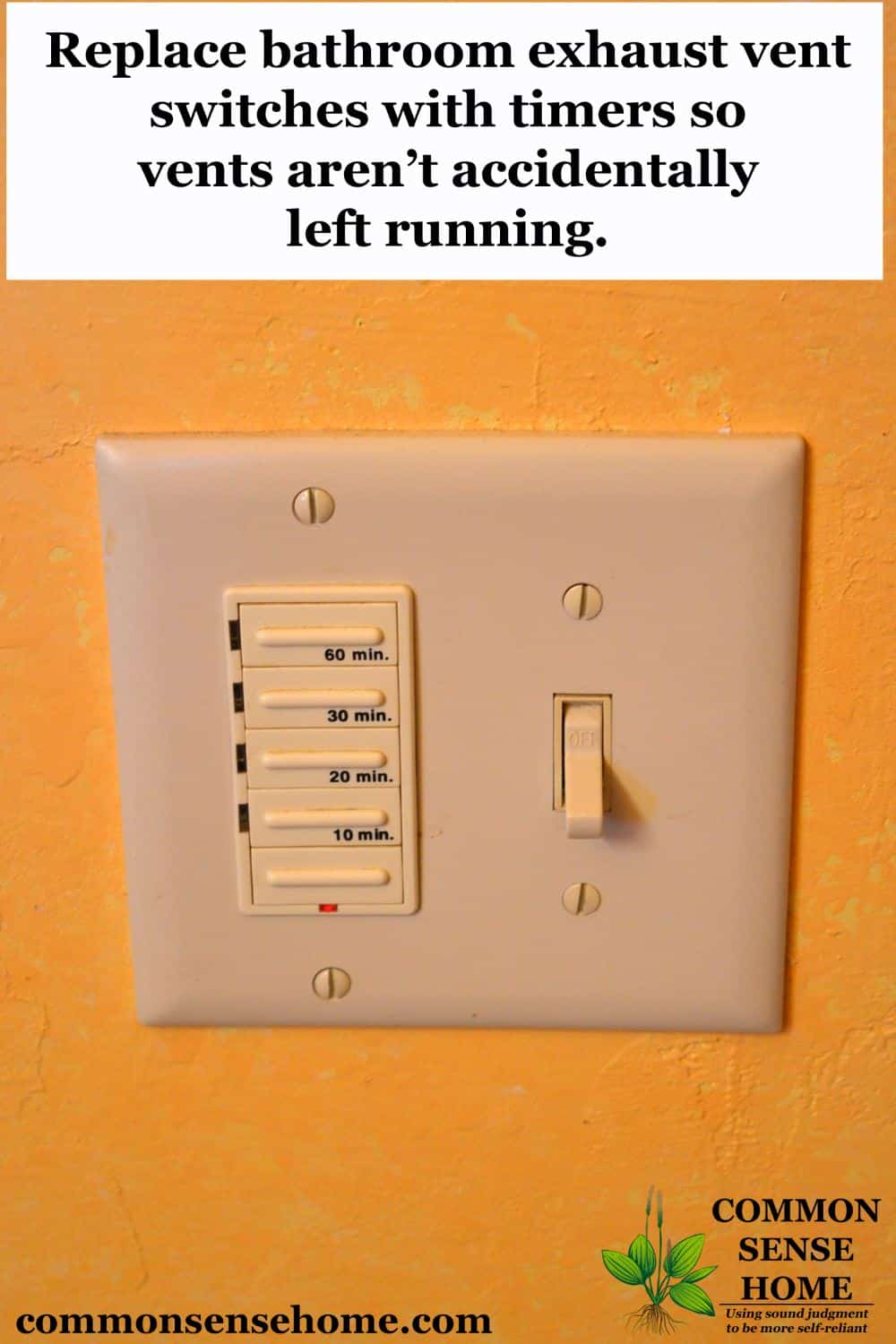
Use the Right Ventilation
1. Replace bathroom exhaust vent switches with timer switches so vents can’t be left on by accident. Vent only when needed. Winter air tends to be dry, so if you don’t mind a little less privacy, open your bathroom door and let the steam escape into the house instead. These are energy saving and can save you money year round!
2. Make sure bathroom fans/vents have baffles/draft blockers on the outside so you don’t have cold air blowing back into the house. They are called a back-draft-dampener or wall-shutter (the sizes must match, so these are just included for reference).
3. Switch ceiling fans (reverse them) spring and fall. If you have heated floors turn off the ceiling fans, if you have forced air heat (central heating) turn it on.
4. Close the doors and vents in unused rooms if you are trying to reduce heating costs or keep your living space warmer in an emergency. Note: Be careful not to let rooms get too cold if they have plumbing, so you don’t end up with frozen pipes.
See “Prevent Frozen Pipes – Extreme Cold Options and Construction Tips” for more plumbing tips.
5. Outside airflow makes a difference, too. Consider a snow fence to control where snow drops and control drifting. See the post How to Put Up a Snow Fence. Even a small snow fence can break the strong winds somewhat.
Get Heat Where You Need It
6. If you have radiators (or baseboard heating pipes) line the inside of the exterior wall with tinfoil or other heat reflecting materials from your home improvement store. This will reflect some of the heat back into the home. The same can be done for ovens, wood stoves and other heat sources internally. Fireplaces and wood stoves need a tougher fireplace reflective shield.
Radiant flooring is also a great solution. This type of heating system puts the heat closer to you, not up by the ceiling.
7. Make sure you aren’t blocking airflow from forced air vents, and that the vents are open where you need heat. Don’t block your vents with furniture, piles of dirty clothes or other debris.
8. If you have a chimney and are not using it, make sure its flue and draft (if it has both) are closed. Open chimneys can suck the heat right out of your home. (This is one of the biggest issues with open fireplaces – too much heat loss from the room. )
Consider blocking the chimney with a fireplace insert insulation to reduce heat loss if it will be left unused indefinitely – just don’t forget to take it out if you decide to use it again. You can use fireblock or brick or stone to create thermal mass near a fireplace or wood stove.
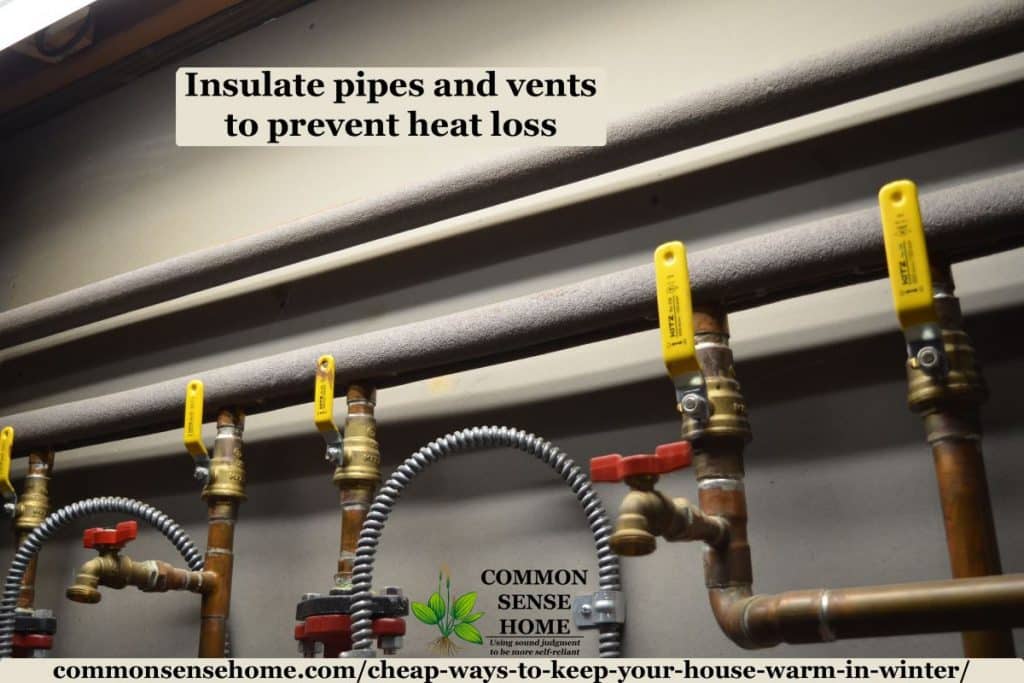
Insulate Inside and Out to Reduce Heat Loss
9. Insulate hot water/radiator pipes and ductwork running through non-living areas. You don’t want lose heat in a crawl space or utility area, you want it to get your house warm. Measure everything before you buy insulation, the links are for reference only.
10. Insulate doors. There are custom door sweep insulation kits you can can place along the bottom of an exterior OR interior door to reduce drafts. There are also insulation (cold air blockers) that can be placed against the base of a door. Garage doors have insulation panels. Keep the cool air OUT.
11. In extreme cold, hang blankets along the wall, even where there aren’t windows, the wall can radiate cold through it. This is especially true if the insulation isn’t good enough. If this happens regularly you need to check your wall insulation.
Don’t forget passive solar. Make sure any windows facing south are uncovered when the sun is out. Get that free heat from the sun.
12. Attic access or attic doors can be the source of large amounts of heat loss. Make sure your attic access is VERY well insulated. Consider an attic stairs insulation cover to reduce heat loss above pull down steps (there are covers to reduce reflect heat for very hot environments also).
Would you like to save this?
13. Don’t let the cold radiate up from your floor. An uninsulated floor can cause more than 10% heat loss in a home. This is especially important if your home is “built on a slab” (no basement). Insulate the floor with warm rugs and/or carpets.
The bearskin or sheepskin rugs were historical solutions for floor insulation. You can also use insulating rugs to keep your feet warm. Also consider wearing warm slippers around the house also.
14. Consider placing bales of hay along the exterior edge of your basement and lower portion of 1st floor of your home. You will need to make sure you protect against mice, they will move in. The hay functions as basic exterior insulation and adds thermal insulating mass.
Reduce Window Heat Loss
15. Uncover the south facing windows to let in solar heat on sunny days. See “Passive Solar Heating Basics” for more information on how to make the most out of your solar gain.
16. Add insulating window coverings. Honeycomb cellular insulating shades are a good option to consider. Home Depot, Menards, Lowes, and numerous websites and stores will allow custom orders. We have Bali insulating double-cellular shades.
We open and close the insulating blinds with the sun. We are have to replace the insulating blinds roughly every 10 years. If you don’t like the insulating shades, consider Insulating Curtains to reduce your heat loss.
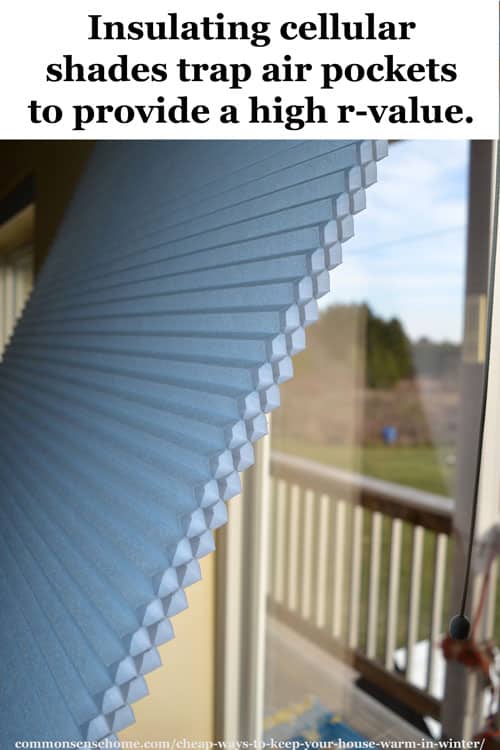
17. Add interior window insulation using something like a 3m insulation kit. These window insulating kits can be combined with the shades or curtains.

18. For a cheap short term solution, use duct tape and an old blanket to cover your windows. It’s ugly, but functional.
19. If you have a really big window and want to reduce heat loss, you can duct tape a large clear shower curtain to the inside (just past the frame). (A shower curtain is thicker than the window insulating kit plastic.) It will allow sun in during the day and still provide an air gap to reduce heat loss. Adding a curtain or shades over it helps even more at night.
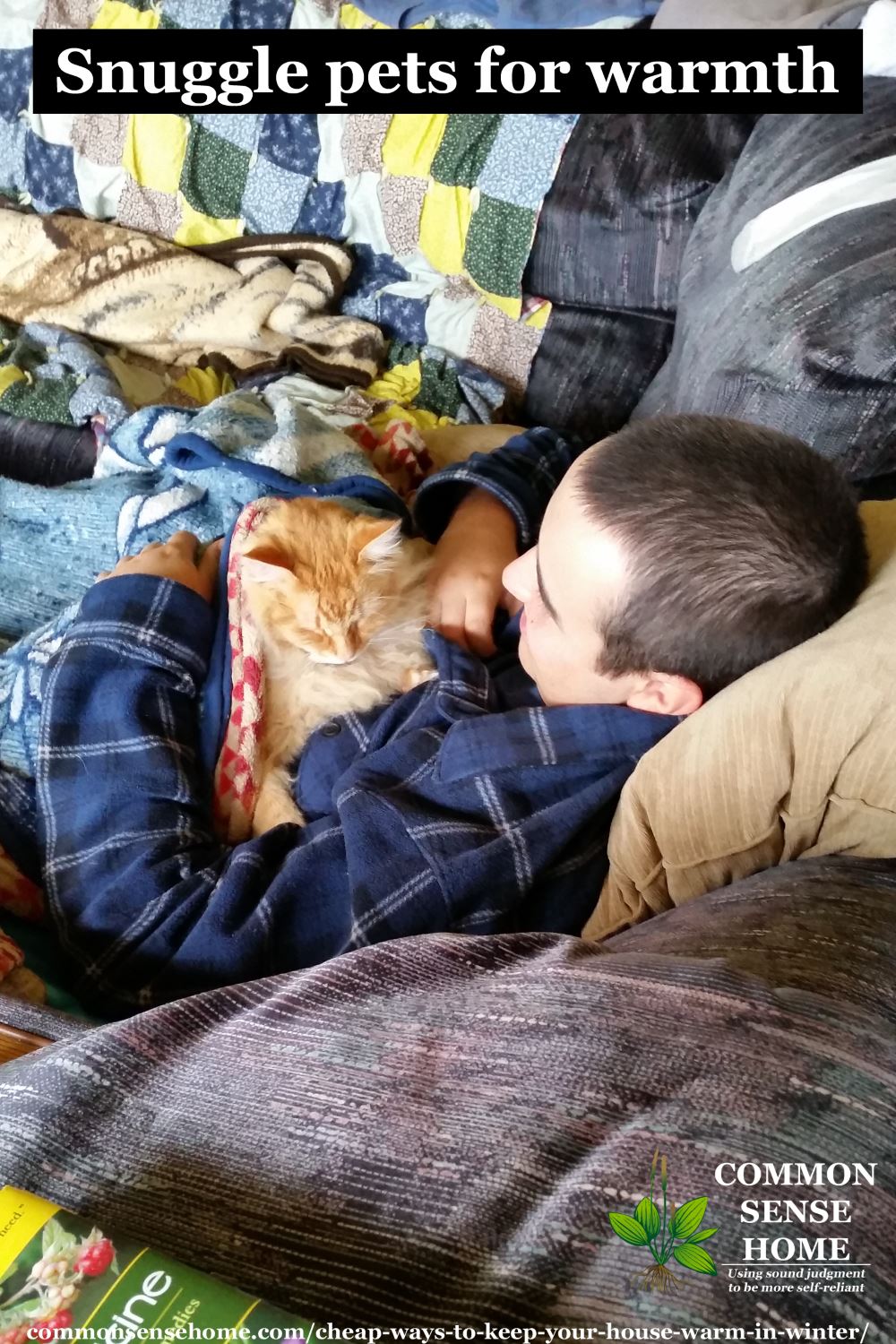
Adding Extra Warmth to Your Home
20. Don’t drain a bathtub that is hot. Wait for it to cool before you drain it. If there’s a storm coming where you may lose power, fill the tub with hot water. You get additional heat in the home and an emergency water source.
21. When you finish baking, leave the stove open slightly to let the home get all that wonderful heat. Winter is a great time to practice your homemade bread baking skills. If you froze fruits and berries in the summer, winter is a perfect time to finish your jam and jelly making.
22. Your pets are mobile heaters. Consider cuddling if it gets really cold. Our cats think movie time is the best thing ever, since they have nice warm humans to nap on.
23. Keep blankets and lap rugs handy and use them. When we sit, our circulation slows down. Keeping a throw blanket over your lap while you’re knitting or watching TV can improve your comfort levels without turning up the thermostat. Wool blankets are best for an extra bed cover layer or couch throw
24. If you spend a fair amount of time at a desk, a heated foot warmer may be a good investment. My mother in law has the Cozy Products TT Toasty Toes Ergonomic Heated Foot Warmer under her desk. It gets a good workout when she’s working on genealogy.
25. Invest in a small, clean burning portable propane heater to add heat only where and when you need it. The 18,000 BTU propane Big Buddy Heater is well reviewed online and by friends who have used it. Stock up on spare propane tanks and you have a perfect emergency heater.
Do you have an inexpensive tip for keeping warm that we missed? Leave a comment and share your thoughts.
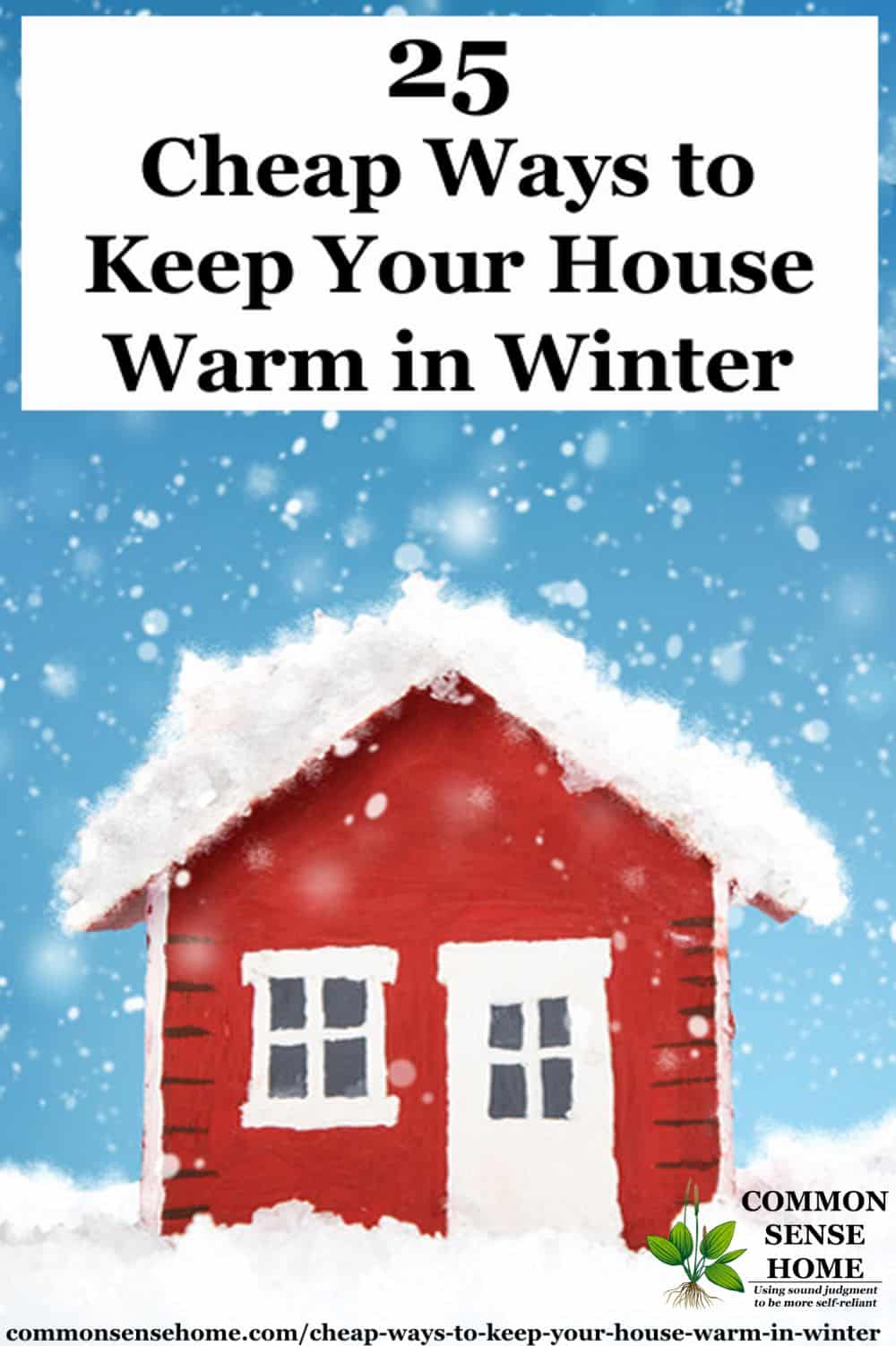
Related Articles
- Emergency Cooking – 10 Ways to Have a Hot Meal When the Power Goes Out
- Emergency Power Options for Your Home
- Thawing Frozen Pipes – 3 Ways to Safely Defrost Plumbing
- Prevent Frozen Pipes – Extreme Cold Weather, Construction Tips
- Winter Car Kit and Winter Vehicle Maintenance Check List
- Best Ways to Keep Your House Warm – New Construction and Remodeling Tips
- What You Need to Know about Masonry Heaters for Radiant Heat

This article is by Laurie Neverman. She has a BS in Math/Physics and MS in Mechanical Engineering with an emphasis in renewable energy. Laurie and her family live in a “concrete bunker” (ICF home) with a permaculture food forest, greenhouses, and three types of solar. They “walk the talk” of preparedness by living a more self-reliant lifestyle.

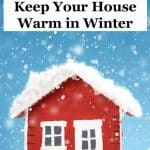
Really great information!!
we only use wood heat from a wood burning stove, it definitely gets cold around here!
I am going to try my hand at at least one window quilt this year for my largest, coldest room.
Build a canopy bed frame and add heavy blankets curtains to contain the heat. You can attach the foam insulation panels instead of the blankets and keep a blanket curtain as a “door’.
Wool sweaters, socks, scarves, etc. will keep you warm and it’s a natural product which is so much better for us.
Also, bootie slippers really keep your feel warm. They have a “cuff” at the top of the slipper that you can pull up around your ankles. They really do keep your feet warm.
Also, layer socks. A thin pair close to your skin (preferably wool) and then thermal or heavy duty socks over those. Layering is key.
I will burn alot of candles, while in the room, it takes that room up a few degrees, one year that truly was the difference between freezing and not.
Please be careful with large amounts of open flames, especially if you keep them lit while sleeping.
Please make sure you don’t have them anywhere pets can get to them! Voice of experience here…I don’t even own a candle now, and never will have another one
Hi, fabulous website filled with lovely ideas and tips – thank you.
My winter tip, I have Dirt Trapper Mats (rubber backed washable rugs) at all the doors and a stone floor. In the winter I turn the last quarter of the rug up so it sits vertically against and covering the bottom of the door, I then have a curtain rail fitted above the doors with a heavy weight or insulated curtain which reach the floor, tuck the curtain against the mat to keep the drafts out.
Mary, Kent, UK.
Thanks, Mary.
We made bean filled fabric snakes to lay at the base of doors to stop drafts. We also always hang a moveable (and removable) curtain above the exterior door frames – makes a huge difference even with modern doors?
If you have black dark out curtains, reverse them so that the black side is facing outward on an east or west window so the curtains will absorb the sun and release the heat into the room. It also helps to use regular florescent and incandescent light bulbs or whatever gives off heat. Since those light bulbs give off most of their energy as heat, they will help heat your home stay warmer, especially if you need a lot of light and very frequently.
1) There’s something called a Heat Grabber that Mother Earth news had plans for in the 1970s. You can find the info here: https://www.motherearthnews.com/diy/diy-solar-heating-zmaz77sozgoe You place it in a sunny side window and the solar warmed air generated rises up into the house. Free heat. 2) Make a removable Triomphe wall by filling darkly painted plastic gallon milk/ water jugs with water. Place these on a system of built-in shelves or removable bricks and boards in front of your large South-facing sliding glass door or window. These absorb the heat of the daytime sun. In the evening, close your insulated curtains behind them, and feel them radiate heat into your home. 3) Cherrystone pads are just cloth bags filled with dried cherry pits. They can be heated in a pan on top of a woodstove and used like a hot water bottle but they also comform to the body part so you could make a long one and wrap it around your shoulders. I assume they can be heated in a microwave, but I don’t know because I don’t own one. 4) Run the heat and enjoy it. We don’t have cable TV or cell phones and save at least $100 a month by not having them. Because of this we can run our heat to a comfortable level. We still wear warm woolens and have insulated walls and ceilings, large wool area rugs, and use thermal curtains on windows, etc., but we decided to forego luxuries for some creature comfort. This is the first place I’ve lived in ages where I don’t need a hot water bottle all the time and we’re warm enough with the thermostat set between 65-67.
i remember these. we saw that issue and promptly built one. ours was more nearly vertical and pulled cool air off the floor inside, routed it thru the heat grabber and it exited higher up on the wall.
Hi Laurie,
I stumbled across your fascinating website this morning while searching for more uses for Aloe Vera. This plant I really value for its many and diverse uses but couldn’t find mention of it on your site, was wondering if perhaps it has a different name over there.
Looking forward to getting familiar with the many useful topics you cover on your site.
Good health from Portugal,
Basil Croeser
Hi Basil. Glad you’re enjoying the site.
I call aloe vera “aloe vera”, or simply “aloe”, but only used it a limited amount at this point for burns and other skin ailments. My plants are small-ish, not the huge type I’ve seen in some areas.
I’ll note your request and see about pulling together an article in the new year, when people are more health focused. (Although it sounds like you may be well able to write an article yourself. 🙂 )
we have living room with vaulted ceiling. off this room is a halway. I have put tension rod and a thick blanket. in the evening we turn down the furnace, close the curtain which keeps heat in stay comfortably while in that room. we like to sleep in the coolness of the turned down furnace when we retire to the bedroom for the night.
Never tell anyone to bring a propane heater into their home. The carbon monoxide could kill them. Years ago after flood a family had them in their home to dry the place out and they all died over night due to the CM poisoning. Please change that in your article.
Deb – That is terrible, but they probably used a heater that was not rated for indoor use.
There are propane heaters specifically rated for indoor use that may be used safely as long as users follow manufacturer’s recommendations. There are guidelines for the space to be heated and ventilation requirements.
all homes need to have carbon monoxide detectors!
Fill a long sock with rice and tie it off. For instant warmth, pop it into the microwave for two or three minutes, take it out and then cuddle with it.
We are going to Florida for the winter. Should we let the house freeze, after emptying the pipes and toilets and drains, or should
we leave the heat on low…and if so, how low.we have heated floors in the kitchen ad one bathroom, the rest is heated with convection baseboards. Also, should we empty the hot water heater? We live in Canada.
Thank-you
For safety (just in case a room where plumbing is on an exterior wall goes cold even if the heating is working), it would probably be best drain the house if you are going to be gone for over a month.
I wouldn’t let the house freeze, because the freeze/thaw process damages materials, even if the plumbing is drained. Keeping the temperature set at 50F (10C) while you are gone should protect the house, and may protect the plumbing without draining.
As I mentioned above, my main concern is plumbing in exterior walls when there are bitter cold temps. Those weeks of “arctic vortex” weather can cause problems even when the heat is running at normal set temps.
This is useful. In the wintertime (I live in England) I have a nice hot roaring fire in my loving room at night time. I also put on central heating too. Another way to stay warn is to buy handwarmers and use a hot water bottle as well. In the olden days, people used to use baked potatoes apparently and melt snow. Also you can use a hairdryer to heat yourself accordingly.
Other options include a small portable electric heater. Or you could always equip yourself with a jacket. Do not forget to turn off at night however.
In Michigan the temps have reached more than 20 degrees (fahrenheit) below zero several times in my life. I had a house that had an extremely cold south wall. I painted the exterior flat black and it was then noticeably warmer (at least ten degrees) even into the night.
Another house I had I also painted the south wall black to very good effect. But on the north side I set up a semi-circle line of mirrors that heated the house so well you could feel the warmth by sticking your hand into the light reflected in the windows.
Lots, and lots, and lots of sex
According the study “Energy Expenditure during Sexual Activity in Young Healthy Couples“, young healthy couples produced an average of 3.6 kcal/min. This equals 14.2 btus/min,or 852 btus/hour. At 40 to 45 btus per square foot (estimated use in cool climates for furnace sizing), you’d need a 100,000 to 112,500 btu furnace to heat a 2,500 square foot home.
Assuming you could engage in energetic sexual activity for an hour straight, you could heat a small room – for that hour.
I’m very envious of Stephen’s canopy bed! My best tip for a warm bed is to put an old duvet under the bottom sheet. Then you’re inside a duvet sandwich, which is divine! I actually sewed a rectangle of dimple fleece to the middle of a cheap fitted sheet and made pillowcases out of dimple fleece too. A-mazingly cosy to get into on a cold night. Also found that a long-pile fleece throw over me and under the duvet works really well. Another few tips: if you’re single, lie a folded blanket down one side of the bed (under the covers). If you take two hot water bottles to bed, you can push one under the blanket and cuddle the other. When the first one has gone cold in the small hours, pull the other one out from its nest and it’ll still be warm. And don’t forget bed socks! (Writing this in glorious June in England – black sky and pouring rain – and thinking about readying my home for winter).
Thanks, Jerri.
I made a modern version of a canopy bed, with all the extras like TV, etc. The house can go to almost freezing (have to mind the water pipes!) but inside the canopy bed it gets as warm as 78+!degrees!!!
Bubble wrap on windows can help keep heat in. Use a spray bottle of water and lightly mist the window and place the bubble wrap directly to the glass. Bubble side against the glass. We peel this off in spring and reuse each winter.
Get Mortite which is a weatherstrip and caulking
cord. I use it to seal the gaps between windows where lots of air tends to blow in. It is cheap, about $8 a box, easy to apply with your hands snd has no odor. Many uses for this.
a cheap alternative to Mortite is rolled up newspaper, place under and around the window (if you can).
I am not sure the idea of having a steamy hot bath to warm the house is a good idea, imagine the moisture level created inside the house once it cools down, the mildews are going to have a feast day! Keeping our home dry is absolutely essential because dampness is the cause of us feeling cold.
In our area of the country, it’s cold enough that the air is quite dry. People run humidifiers to moisturize the air.
Great tips. Try to keep ourselves warm rather than the whole house. Besides the old fashion water bottles, my wife and i have electric mug warmers. They use only 14 watts of electric each, add some moisture to the air, and warm us up a bit. We got some plant seed warmer pads (use about 17 watts each). Put them under the plants so they gave give off heat after the heater are turned off. Lastly we each had foot warmers – on high they use 90 watts each. By using these smaller heaters, we save the 600 watts of power that is used ever time our central heating blower turns on. Not only has our electric bill gone done but we are using less oil then ever before. They say the average home in the northeast uses about $2500 a year on oil. We use half of that. This year it may even be less.
Well done.
I live in a large 125 year old farmhouse out in the sticks. Electricity is not always something I can rely on. Big wrap around porch shades all windows so no solar window gain.
Here are my survival tips.
*Rigid board insulation in the windows. Cut to fit tight and tape around to seal any gaps.
*Japanese Hot water bottles are rugged, will hold heat 12 hours and do not leak. You can get the metal ones and put them on a stove or use boiling hot water in the plastic ones. They come with a cloth cover or you can wrap them in a towel.
*Area rugs. These can be cleaned each spring and rolled up for winter so you wood floors cool in the summer but the rugs warm in the winter. (shop sales)
*Eva interlocking floor mats. These are cheap & easy to put out. I put these down in areas that an area rug is not functional. Closet floors, Kitchen etc.
*Cut to fit washable bathroom carpet. This is specially made for bathrooms and can come back up and go in the washing machine. Dry on low in a dryer or the rubber backing could melt.
*Visqueen sheeting taped over the outside and inside of unused exterior doors. I have 6 exterior doors but really only use one. In an emergency, the plastic sheeting can be pulled down to exit.
*Rigid insulation sealing unused fireplaces.
*Emergency blankets (these are shiny metal and run a buck or two) These reflect heat back. I have them sealing the fronts of inwall air conditioners and anywhere else air escapes.
*Cow hides over the top of the all the blankets on the bed. I don’t do this because I don’t have cow hides, but when I was a kid, mom would throw a cowhide over each bed as part of the tucking in ceremony for us kids.
*Flannel under the fitted sheet. I just can’t stand flannel sheets, but I’ve found that putting a flannel blanket under percale sheets holds in the heat.
*0 degree extreme sleeping bags on the really cold nights. Put them on the bed and snuggle up.
Future plans. A wood burning furnace, Reflectix, Cork flooring or subflooring.
Thanks for sharing all your tips, Jill.
Some utilities provide free home energy audits. If available, this might help you determine the best “bang for your buck” in terms of energy efficiency updates. The older farmhouses (in my experience) tend to have almost no insulation and weatherstripping, so even modest improvements can make a big difference in comfort levels and heating costs.
Update: Managed to keep the electric bill under $28 a month for the last year and a half now. The propane last year was $400 (heater, dryer, stove). I’d still like to not have the propane cost. Looking into the DIY soda can solar heaters or fireplace inserts that don’t require electricity.
That electric bill is crazy cheap. They charge us more than that per month simply to keep the power connected.
On the east coast, electricity is crazy expensive! It’s over 15 per kWh!
REROUTE THE AIR FROM YOUR DRYER!!
The best thing I’ve learned through the years to cheaply heat my house in the winters is to reroute the hot air from my clothes dryer. If you don’t own a stock in the electric company, stop wasting the heat you pay for when you dry your clothes.
So instead of heating the outdoors by letting the dryer push air out, let it warm your home by rerouting the vent to push hot air inside.
All you need is:
-A bucket with a lid- mine is roughly 2 or 3 gallons. Don’t get anything smaller.
-A flexible coil vent
-Water
-A drill with (large) drill bits (or something to cut the lid with)
Directions:
Now basically destroy the lid of your bucket. It felt stupid to do this, but it’s necessary to make holes in the lid of the bucket. One hole needs to be big enough to fit the flexible aluminum tube that carries the hot air from your dryer. Then drill a few other holes for the hot air to escape. Mine has 8 small holes that all measure about 1/4 inch. I drill the big hole in the very center of the lid and drill the smaller holes in a circle around it. However, it doesn’t really matter where you place the holes, so long as your dryer vent fits in the big hole and hot air can escape through the little holes. Just make sure you can still pop the lid on to the bucket tightly
Next, fill the bucket about 1/2 of the way with water. The purpose of the water is to filter out the lint that usually just blows outside. It also acts as a great humidifier when the air gets cold and dry. Feel free to add essential oils to the water, too! It will smell awesome throughout your house.
Now, place the lid on the bucket, and shove the aluminum tube in about 3 inches.
If your big hole is too big and the vent doesn’t want to stay put, there’s an easy fix. Usually, when you buy a flexible aluminum tube, it comes with a circular metal clamp. Once you get the tube in, put the clamp around the vent and secure it in place on the inside of the lid.
Now, turn your dryer on! Voila! “Free” heat- or at least it won’t cost you any extra in heating costs.
You are welcome. 🙂
This will work (if the humidity isn’t a problem). I lived in a couple of houses where this was done. In both homes, a pair of panty-hose were used as the lint filters. It worked in the older homes that could breathe, but the added humidity can cause real problems. Older homes that “leak” or breathe can generally better deal with the humidity. Very tight newer homes can have serious problems with the humidity, including black mold. Our fix was to use a Heat Recovery Ventilator (HRV) to avoid the humidity. We use the Fantech HRV. It is expensive but it works. A 2nd benefit is that it brings in warmed fresh air. Also consider a gas dryer, as natural gas and propane should remain fairly inexpensive.
Really Great list. Personally I find that traditional ways of keeping warm often work best. A hot water bottle always keeps me toasty. I also rely on my draught excluder to keep our living room warm. And I’m always nagging everyone to close the doors behind them and keep the heat in!
Sleeping in a pop up tent, in the house (with as many buddies/pets as possible too) will trap body heat in… for those desperate nights. It kinda makes extreme situations kinda fun. I said kinda. Any “tent” set up is a good aid to trap body heat. My husband was stuck in his car once and “tenting” helped him greatly.
Another cheap and unusual way to keep the warmth into your home: use kitchen, aluminum foil on the wall behind the radiators under the windows. The shiny side of it will help the heath bounce back inside your room rather than escaping out the windows.
Thanks for the tips, great read!
Place blankets UNDER your fitted sheet. This help keep the cold from coming up under the bed. I have a heated blanket for my car that plugs into the auxiliary sockets like a electric blanket in case I get trapped in my car.
Draft dodger for the doors to keep the cold from coming in under the doors.
Heat bricks and wrap in towels place at foot of bed under the covers.
insulation strips around all windows and doors to keep out cold.
Cover inside and out side of windows with clear plastic to stop drafts from coming in.
Draft dodgers can also be set on window sills to block more cold from coming in.
If the power goes out do not open the fridge door any more than necessary. Keep the most used item in an ice chest like milk or other drinks so they are easier to get to.
Lined plastic table cloths over windows to hold out drafts better.
Thanks, CC.
I actually keep a few flat rocks on my wood stove when I’m not cooking on it, in winter. Then, I take one, wrap it in a towel and put under my feet when using the computer or lay at the foot of the bed, under the covers, to pre-warm it in the cold room I sleep in, since I don’t heat upstairs where the bedroom is. A hat with earflaps I can tie under my chain to keep it from pulling off, helps at night too when it is extremely cold. We can adapt to the cold, the heat is more difficult.
what is the best method to keep plastic or bubble wrap on windows during winter plez
To apply bubble wrap – spray a light film of water on the window, press on bubble wrap, bubble side down.
This is the first time that I have seen hot water bottles recommended. I think they went out of fashion as electric blankets and central heating seem to be the norm these days. Hot water bottles are great to cuddle up to in the daytime and during the summer I put them in the freezer for those uncomfortable hot nights.
Everything old is new again. I really like our Core products hot/cold packs, too, as they have more thermal mass than water and so hold the heat longer. They do require a microwave to heat, so if that’s not an option, a hot water bottle is a functional substitute.
how about hot or warm bricks wrapped in a cloth as my dad used to help keep his feet warm.
Nothing wrong with that. I have that included in the “no more cold feet” post.
The cold shower thing would never work for a person with Raynauds! Could lose fingers and toes(frost bite). I freeze in the Summer haha!
Yes, you certainly have to be mindful of health conditions. My niece deals with Raynauds, and it can be challenging.
One of the best ways to keep warm in my opinion is to build your own cold resistance. I do this by taking cold showers. By cold, I mean COLD. All the way cold with no heat. It’s easiest to start doing it in summer and then move into the winter. But if you do it enough and learn to tolerate the cold water with different tricks, you’ll become cold tolerant and you’ll actually start to love the cold.
Regular cold exposure may also help stimulate healing and promote overall health. It’s popular in some parts of the paleo/primal circles. (For instance, Mark Sisson mentions it in his book Primal Blueprint.) And of course, the Nordic countries have long enjoyed cold exposure in combination with sauna use.
Don’t do this one if you are on blood thinner medication.
OMG Holden!! A cold shower would seize me up for days! It sounds like torture, but if it works for you, hey, good on ya. How “cool” that we are all so different.
….forgot to mention – My Scottish Gramma kept a bottle of cherry brandy in her closet – “just a nip to warm the insides” on cold nights.
This also greatly boosts the immune system. Heard of a man in Russia who decided to commit suicide because he had terminal cancer. He went outside in sub zero weather almost naked. He actually cured his cancer.
Use pool noodles for drafts in doorways/doors
I wouldn’t think those would stay in place very well because they are so light, unless the gap is big enough that you can jam them under the door.
Rather than pool noodles, use pipe insulation ‘noodles’. Or slit the pool noodle so it will fit over the bottom edge of the interior door. Also, I have windows that I have cut foam insulation boards to fit. I cover the 2″ foam board with fabric, making a pleat that runs on each side, to prevent air movement. This has been a life saver for me at times. Sew in little loops of fabric near the side pleats to pull out the inserts when desired.
Use a foil blanket under the bottom sheet and on top of the upper sheet. The foil blankets help reflect your body heat back at you.
Wear thicker, warmer clothing, like fleeces, woollen jumpers, thick socks!!, etc. At night use the fleece or woollen blankets on your bed. Revert back to sheets, brushed cotton, and blankets using your quilt on top. Hot water bottles are a must, and if you have younger children, refill theirs before you go to bed. Lastly family cuddles of an evening under duvets, blankets etc then on really cold nights consider ‘buddy’ sleeping, ie sleeping together.
Great tips! Thanks.
You’re welcome.
For those trying to keep warm, if the heat goes out.. cover over ur dining room table with heavy quilts. Put ur sofa pillows on the floor under the table, making a tent . Body heat will help keep it warm beneath the table. Keep an ice chest with water, snacks,etc. Close by..
Here is something that I happened upon many years ago when I could not afford to have the baseboard heater on in my bedroom: Instead of sleeping with a sheet over you, then blankets and quilts on top of that, have a knitted or crocheted blanket/afghan over you, then the sheet on top of that, and then any added blanket(s). The knitted blanket against your skin with the sheet over it traps your body warmth amazingly well. The kids always had hot water bottles with the heat on low in their rooms. Taking Fido into bed was also helpful. You’ve heard the expression “it’s a three-dog night”? That means it’s so cold you need to have three dogs in bed with you – just one or two are not warm enough!
Good tip. I hadn’t thought about using the knitted blanket right next to the skin. And keeping your feet warm makes a huge difference in comfort. Our current place holds the heat better, but I remember back in the old farmhouse growing up, pulling my clothes into bed with me to warm them up a little because the bedroom was so cold.
i have done this many a time…even still sometimes if i happen to wake up to a cold morning and i had the sense to put them beside the bed the night before!
I agree. I have 4 dogs. They make wonderful bed mates.
Use pool noodles for drafts in doorways
my grandmother completed her pHD seated at a typewriter in a full ski suit with two hot water bottles in it. we were always taught that its a crime to heat a whole house just to keep the space of one person warm. yes, we are scottish.
My compliments to your grandmother’s frugality, sturdiness and intellect.
we always layer beds like so: hot water bottles, thin cotton sheet, quilt with wool batting, tweed blanket, downy cover (with real feathers- plastic is NOT insulating but does trap moisture), lightweight thin tweed blanket, lightweight large sheepskin.
light layers on top prevents feathers from getting squashed airless.
this works down to minus 10 outdoor AT LEAST, even for a skinny person.
Do you need to heat the house at all, other than to keep the pipes from freezing?